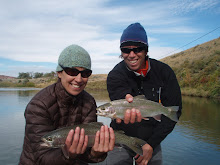by Tom Rosenbauer
Excerpted from The Orvis Guide to Prospecting for Trout: How to Catch Fish When There's No Hatch to Match, Revised Edition (The Lyons Press, January 2008, 208 pages)
(The Lyons Press, January 2008, 208 pages)
IMPARTING MOVEMENT TO A DRY FLY is one of the most effective and exciting ways to fish dry flies, but it must be done under the right circumstances with special techniques that distinguish movement given to the fly by the fisherman from ordinary drag. Insects on the surface of the water move, no question, but when insects move they do it without creating a V-shaped wake that drag usually creates. When you purposely give movement to a fly, it should look like a skater gliding across the surface rather than a swimmer doing the crawl. If this is done properly, a skated fly will draw trout from six feet away, fish that might not be induced to take any other fly. It's more an active technique that you should use like a streamer fly to provoke strikes than a passive technique where you pitch a fly to a trout's suspected position and wait for him to inhale your fly. Read more...
IMPARTING MOVEMENT TO A DRY FLY is one of the most effective and exciting ways to fish dry flies, but it must be done under the right circumstances with special techniques that distinguish movement given to the fly by the fisherman from ordinary drag. Insects on the surface of the water move, no question, but when insects move they do it without creating a V-shaped wake that drag usually creates. When you purposely give movement to a fly, it should look like a skater gliding across the surface rather than a swimmer doing the crawl. If this is done properly, a skated fly will draw trout from six feet away, fish that might not be induced to take any other fly. It's more an active technique that you should use like a streamer fly to provoke strikes than a passive technique where you pitch a fly to a trout's suspected position and wait for him to inhale your fly. Read more...




No comments:
Post a Comment